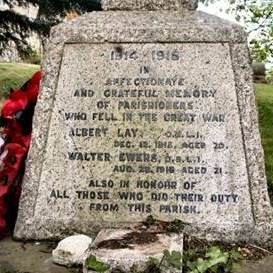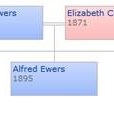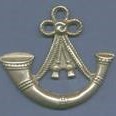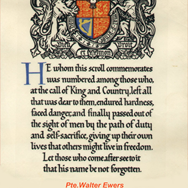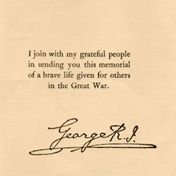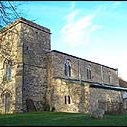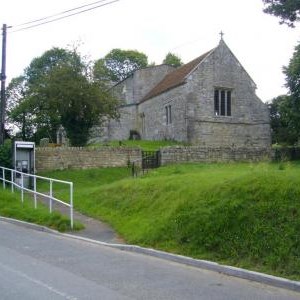St Mary's Church

The Bernwode Benefice and Calender
The church stands in a prominent position in the village and is in regular use for services details of which may be seen in the village diary on this site. It consists of a nave built early in the 12th century with a south aisle and south porch, a chancel and a west tower. The church is of limestone rubble with patches of herringbone masonry in the north wall of the nave, where there is also a completely plain, round-arched doorway. The walls were originally plastered internally but this has been removed. At the east end of this north wall is a blocked arch which led to a chapel which was the burial place of the Falconer family. The roofline is clearly visible on the exterior. A date of 1554 was visible over the door to this chapel but it is probably 14th century in origin to judge from the arch profile and the west capital. The east capital is castellated and may reflect a 16th century modification of the chapel. There are the remains of the rood-loft to be seen on both sides of the nave, and a squint from the south aisle into the nave at the east end.
The nave was lengthened westwards at the beginning of the 13th century, for which a single plain lancet provides the evidence. The nave roof was heightened in the 15th century, when a clerestory was installed. The south arcade is in two parts. At the west end is a single 12th century round-headed bay cut through the wall, with broad rectangular piers to the east and west and the arch supported on imposts. The two eastern bays are 14th century, with moulded capitals, double-chamfered arch and an octagonal pier. The chancel is 19th century, and the low, two-storey west tower is 15th century, with diagonal buttresses and Perpendicular west doorway and window. It contains three bells and a sanctus, the first by Robert Atton 1633, the other two and sanctus by Henry Bagley 1658. The font has a circular tapering bowl, of hard limestone with a large roll moulding around the bottom and is probably 12th century. The wooden font cover is 17th century and is hexagonal in design, with a central pendant.
In the chancel in a recess on the north side is a recumbent effigy of a knight, in chain mail with surcoat to his knees, a sword, a shield bearing arms, a chevron, legs crossed indicating a Crusader with his feet on a lion of Purbeck marble. It is probably late 13th century. The neck has been broken at some time and the repair gives his neck an elongated appearance. His left foot is broken and there are traces of colour on sword belt.
There are two piscinae, one in the chancel of the 13th century with chamfered trefoiled head, the east jamb probably modern. The second is in the south aisle with trefoiled two-centred head, chamfered jambs, and is early 14th century. The pulpit is five sided with raised panels, moulded rails and cornice circa 1700.
With thanks to The Corpus of Romanesque Sculpture in Britain and Ireland for allowing us to copy detail from their website.
Historical accounts of the church are found in The History and Antiquities of the County of Buckingham, George Lipscombe, recorded in 1829 and The Buildings of England, Buckinghamshire by Nikolaus Pevsner and Elizabeth Williamson. These are transcribed on the document at the bottom of this page (Lipscombe and Pevsner).
The Churchyard
Burials have probably taken place in Ashendon churchyard for over 900 years but the earliest date of death recorded on a gravestone is 1701 (Joseph Humphreys).
The spreadsheet at the bottom of this page (headstones and monuments) has 3 tabs. Click on each one to see:
- Alphabetical list of names
- Full list of headstones with inscriptions
- List of monuments in the church
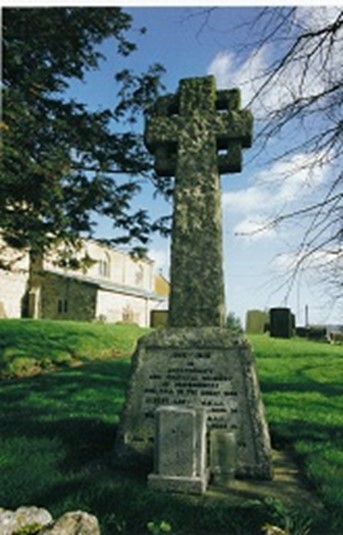
The information that follows is mainly from The Commonwealth War Graves Commission (CWGC) website, Buckinghamshire Remembers website and Find a Grave website. If you have any other information or photographs, please send them to us.
Albert Lay was born in Church Hanborough, Oxfordshire in 1895. In 1911 he was a farm worker living at Mill Street, Eynsham, Oxfordshire. He enlisted in Oxford and was a private no 17172 in the Oxford & Bucks Light Infantry, 5th battalion. He was then a resident of Ilmer, Bucks and died, age 20, on 12 December 1915 in Flanders. His parents were Albert Lay, a general labourer, who died before his son and Elizabeth Lay who was living at the time at 26 Harlesdon Road, Willesden Green, London. He is buried in grave no. C.15, Potijze Chateau Wood Cemetery, Ieper [Ypres], West Flanders, Belgium.
Potijze was within the Allied lines during practically the whole of the First Word War and although subject to incessant shell fire, Potijze Chateau contained an advanced dressing station. Potijze Chateau Wood Cemetery was used from April 1915 to June 1917, and three times in 1918.
Walter Ewers was born in Upper Pollicott in about 1897, was baptised in St Mary’s Church, Ashendon on 29 June 1897 and became a farm labourer as did his father, George Ewers, before him. He enlisted at Aylesbury into the Machine Gun Corps (Infantry) 5th Battalion, private no. 73304. George and his wife Elizabeth Caroline were still living in Upper Pollicott on 28 August 1918 when Walter died of his wounds in France age 21. He is buried in Mory Abby Cemetery, Departement du Pas-de-Calais, France, grave no. IV.B.25.
Mory was occupied by Commonwealth troops in the middle of March 1917. It was lost after obstinate defence by the 40th and 34th Division a year later and recaptured towards the end of the following August, after severe fighting, by the 62nd (West Riding) and Guard Divisions. The German burials in a plot on the west side of the cemetery were made by German troops in March-August 1918, or by Commonwealth troops in September 1918. The Commonwealth plots were begun at the end of March 1917 and carried on by fighting units until March 1918, and again in August and September 1918, as far as and including Plot III. The graves in Plots IV and V - including many of the Guards Division, and chiefly of 1918 - were added after the Armistice from the battlefields between St. Leger and Bapaume. They also included concentrations from a number of smaller cemeteries in the area.
Gerald Ewers was born in about 1905 in Ashendon and lived with his parents, Moses, a farm labourer, and Adeline Matilda, in what is now Rose Cottage in Lower End. He enlisted in the Dorsetshire Regiment, 5th battalion, private 5334713. He died on 3rd August 1944 age 39 and is buried in grave XI. C. 10 Tilly-sur-Seulles War Cemetery, Departement du Calvedos, Normandy, France.
The Allied offensive in north-western Europe began with the Normandy landings of 6 June 1944. There was heavy and fluctuating fighting in the vicinity of Tilly-sur-Seulles immediately after the landings involving chiefly the 49th and 50th Divisions. Tilly itself was not captured until 18 June and fighting continued nearby until mid July.
Walter Ewers
The following information has been researched by Sian Miller.
Walter Ewers is one of two names on the Ashendon War Memorial for the First World War.
His Ewers family line has lived in Ashendon since at least 1700.
Walter was born and raised in what was then a modern cottage (now ‘Victorian’) in the tiny hamlet of Upper Pollicott, Ashendon, Bucks.
At the outbreak of WW1 Walter was working as a farm labourer in Ashendon.
In WW1 Walter fought in the Oxford and Bucks Light Infantry – 5th Battalion – Machine Gun Corps.
He was the fifth (of ten) children born to George and Elizabeth Caroline (EC) Ewers (nee Collins – the second daughter of a shepherd from Towersey).
George was the brother of Moses, Jacob and Pharaoh. Pharaoh and his family (4 children) lived next door in number 2 Upper Pollicott. Moses had 9 children living in Ashendon. Jacob had 3 children. Angelina their oldest sister wasn’t married and Elizabeth was married to Henry Bunyan (born in Pollicott but moved to Aylesbury).
Walter had 4 further sisters - Alice Ellen (Nellie) (1901); Eva Elizabeth (1903); Mary Louise (1906) and Mabel (1909). There was also a baby boy, Joseph George Ewers, who died on 1st April 1891. George and Elizabeth moved into their newly built home at 3 Upper Pollicott at some time in 1891.
Walter belonged to a very big Pollicott and Ashendon family and so many people will have felt his loss and would also have been very proud of him.
Walter was Des Smith’s (of 3 Upper Pollicott) uncle. Des’ Mum was Mary Louise Ewers, his Dad was Sid Smith. Des remembers all his aunts and uncles – except of course Joseph and Walter who died before Des was born.
Walter enlisted with the OBLI on 30 October 1915 in Aylesbury. Edwin (his younger brother enlisted on 1st August 1916)
He joined the Oxford & Bucks Light Infantry which he was attached to the tunnelling corps. On 5th Feb 1917 he transferred to the Machine Gun Corps.
He was posted to the 2/1st Bucks Battalion in France & later transferred, probably while in France, as No 73304, into 5th Battalion, Machine Gun Corps.
Each battalion had, in 1914, a Machine Gun Section consisting of a Lieutenant, a Sergeant, a Corporal, 2 Drivers, a Batman and 12 Privates trained in the maintenance, transport, loading and firing of the Vickers heavy machine gun. These men made up two six-man gun teams.
By February 1915 the allocation of machine-guns to each battalion had been doubled to 4.
Nearly a quarter of its strength became casualties, a reflection of its constant front-line presence, often in exposed and dangerous positions. This led to the Corps being christened “The Suicide Club” by the rest of the Army, but its members had an enviably high and lasting esprit-de-corps that deservedly earned them a large number of awards for valour and gallantry.
5th (Service) Battalion - Action
Formed at Oxford in August 1914 as part of K1 and attached to 42nd Brigade in 14th (Light) Division.
21 May 1915: landed at Boulogne.
27 April 1918: reduced to cadre strength.
16 June 1918: transferred to 16th Division and returned to England.
20 June 1918: absorbed by 18th Bn, the Gloucestershire Regiment.
18th (Service) Battalion
Formed in Clacton on 20 June 1918 from cadre of 5th Bn, the Ox & Bucks Light Infantry.
2 July 1918 : attached to 49th Brigade in 16th Division.
Landed in France 1 August 1918.
Walter was wounded by shrapnel 3 times while he was serving. Twice to the knee and finally a wound to the back which he died from 3 months later (it is likely that blood poisoning killed him as it did so many people with shrapnel wounds.)
Walter died of his wounds on 28th August 1918. He must have received these wounds before his battalion left France in June 1918 as he died 3 months after receiving them. So he will have stayed in France when they returned home and did not fight again.
Edwin Ewers, as Regimental Number 204587 did serve in the Regiment, also in the 2/1st Bucks Battalion and survived the war. In 1918 he was wounded in the right thigh which caused a slight fracture of the femur and he was eventually discharged unfit for service on 27th September 1919. He returned and farmed in Andover, Hampshire
Hayden Ewers also enlisted and gave his address as Pollicott. It was assumed by the regiment that he was a brother of Edwin and Walter but he wasn’t. Hayden was the son of Frederick Ewers and Elizabeth Guntrip who lived in Ashendon. Walter and Hayden’s grandfathers were brothers.
George Henry Johnson was born in about 1922. He enlisted in Royal Corps of Signals and served in 142 Regiment, Royal Artillery, Signals Section as a signalman (no. 2598576) until his death on 31 July 1944. He is buried in Caserta War Cemetery, Italy (1, C, 11). His parents were William Henry Johnson and Beatrice Ada Johnson.
On 3 September 1943 the Allies invaded the Italian mainland, the invasion coinciding with an armistice made with the Italians who then re-entered the war on the Allied side. Allied objectives were to draw German troops from the Russian front and more particularly from France, where an offensive was planned for the following year.
The Royal Palace at Caserta served as headquarters for the Allied armies in Italy for the greater part of the duration of the Italian campaign and the 2nd General Hospital was at Caserta from December 1943 until September 1945. Some of those buried here died in the hospital, others as prisoners of war (there was a POW Hospital at Caserta) before the Allied invasion. There are also a few burials from the October 1943 fighting on the River Volturno, which lies not far away to the north.
Albert John Long was the son of Arthur Thomas Long and Edith Ellen Long of Ashendon. He enlisted in 1st Bn., Oxford and Bucks Light Infantry, no. 5389165, and died, age 28, on 13 August 1944. He is buried in Banneville-la-Campagne War Cemetery, Normandy, France.
The Allied offensive in north-western Europe began with the Normandy landings of 6 June 1944. For the most part, the men buried at Banneville-la- Campagne War Cemetery were killed in the fighting from the second week of July 1944, when Caen was captured, to the last week in August, when the Falaise Gap had been closed and the Allied forces were preparing their advance beyond the Seine.
George Sidney Johnson is not commemorated on the war memorial. He was born in Ashendon on 26 October 1910 son of George Hubert Johnson, a railway plate layer and army pensioner, and his wife, Miriam Jane. He married Annie whose last known address was in Waddesdon. He enlisted as a gunner no. 1094232 in 148 (The Bedfordshire Yeo.) Field Regt., Royal Artillery and died on 4 September 1943 at the age of 33. He is buried in grave 5.E.7 at Chungkai War Cemetery, Kanchanaburi, Thailand.
The notorious Burma-Siam railway, built by Commonwealth, Dutch and American prisoners of war, was a Japanese project driven by the need for improved communications to support the large Japanese army in Burma. During its construction, approximately 13,000 prisoners of war died and were buried along the railway. The graves of those who died during the construction and maintenance of the Burma-Siam railway (except for the Americans, whose remains were repatriated) were transferred from camp burial grounds and isolated sites along the railway into three cemeteries at Chungkai and Kanchanaburi in Thailand and Thanbyuzayat in Myanmar.
Chungkai was one of the base camps on the railway and contained a hospital and church built by Allied prisoners of war. The war cemetery is the original burial ground started by the prisoners themselves, and the burials are mostly of men who died at the hospital.
Alfred Ernest Payne is not commemorated on the Ashendon War Memorial. He was born in Portsmouth, the son of Ruth Payne, and married Ellen Ewers of Ashendon who was probably the daughter of Joseph Ewers, a farm labourer, and Mary Ewers, between September and December 1908 in the Aylesbury area. Alfred was a regular soldier, a corporal saddler in the 1st Cavalry Brigade in 2nd Dragoon Guards (Queen’s Bays) “A2” Squadron (service no 5232). In 1911, both he and Ellen were living in army accommodation at Wellington Lines, Aldershot as was their son Leslie who was one year old and also born in Ashendon. Alfred was killed on 13 May 1915 in Flanders and Ellens address was given as Ashendon. Alfred is commemorated on the Menin Gate, Ypres.
The Menin Gate is one of four memorials to the missing in Belgian Flanders which cover the area known as the Ypres Salient. Broadly speaking, the Salient stretched from Langemarck in the north to the northern edge in Ploegsteert Wood in the south, but it varied in area and shape throughout the war.
The Salient was formed during the First Battle of Ypres in October and November 1914, when a small British Expeditionary Force succeeded in securing the town before the onset of winter, pushing the German forces back to the Passchendaele Ridge. The Second Battle of Ypres began in April 1915 when the Germans released poison gas into the Allied lines north of Ypres. This was the first time gas had been used by either side and the violence of the attack forced an Allied withdrawal and a shortening of the line of defence.
There was little more significant activity on this front until 1917, when in the Third Battle of Ypres an offensive was mounted by Commonwealth forces to divert German attention from a weakened French front further south. The initial attempt in June to dislodge the Germans from the Messines Ridge was a complete success, but the main assault north-eastward, which began at the end of July, quickly became a dogged struggle against determined opposition and the rapidly deteriorating weather. The campaign finally came to a close in November with the capture of Passchendaele.
The German offensive of March 1918 met with some initial success, but was eventually checked and repulsed in a combined effort by the Allies in September.
The battles of the Ypres Salient claimed many lives on both sides and it quickly became clear that the commemoration of members of the Commonwealth forces with no known grave would have to be divided between several different sites.
The site of the Menin Gate was chosen because of the hundreds of thousands of men who passed through it on their way to the battlefields. It commemorates casualties from the forces of Australia, Canada, India, South Africa and United Kingdom who died in the Salient. In the case of United Kingdom casualties, only those prior 16 August 1917 (with some exceptions). United Kingdom and New Zealand servicemen who died after that date are named on the memorial at Tyne Cot, a site which marks the furthest point reached by Commonwealth forces in Belgium until nearly the end of the war. New Zealand casualties that died prior to 16 August 1917 are commemorated on memorials at Buttes New British Cemetery and Messines Ridge British Cemetery.
The YPRES (MENIN GATE) MEMORIAL now bears the names of more than 54,000 officers and men whose graves are not known. The memorial, designed by Sir Reginald Blomfield with sculpture by Sir William Reid-Dick, was unveiled by Lord Plumer on 24 July 1927.
